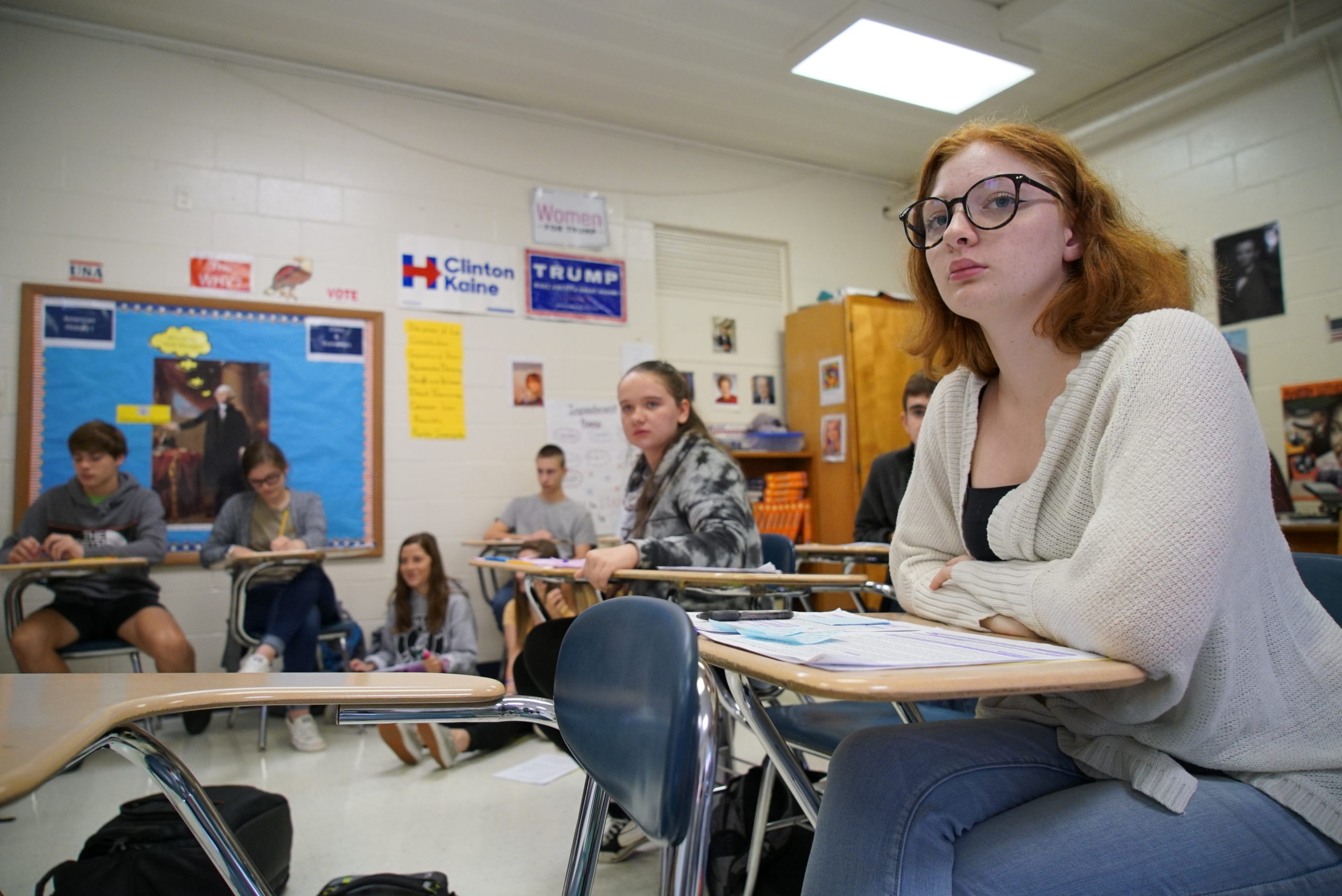Could Corporations Control What’s Taught in Our Public Schools?
A growing number of parents, teachers and experts in academia sound the alarm about a dangerous new form of school privatization. Allen G. Breed / AP
Allen G. Breed / AP
The national discussion about the movement to privatize America’s public schools has mostly focused on the issues of charter schools and school voucher schemes. But a growing number of parents, teachers, and public school advocates, as well as experts in academia, are increasingly warning about another form of school privatization.
You don’t hear very much about this form of privatization in national forums and mainstream news outlets, but it’s being talked about in places like Chesterfield County, Virginia, which borders state capital Richmond.
At a public assembly in Chesterfield in September 2019, an audience gathered to view the movie “Backpack Full of Cash,” a feature-length documentary narrated by actor Matt Damon that exposes how charters and vouchers financially endanger public schools and redistribute resources and students in inequitable ways.
Yet the panel discussion that followed the film quickly veered away from talking about charters and vouchers when one of the panelists, middle school teacher Emma Clark, called the audience’s attention to “a different offshoot of the privatization movement. The privatization we’re seeing here in Chesterfield is through CTE.”
CTE, Career and Technical Education, is a rebranding of what has been traditionally called vocational education or voc-ed, only in the souped-up version, course offerings emphasize science, technology, engineering, and math (STEM).
But in communities like Chesterfield, STEM-related CTE curriculum is increasingly being created not by educators but by big businesses such as Amazon, Cisco, and Ford.
And Virginia’s embrace of a business-driven CTE goes beyond the rewriting of the curriculum. It’s about sorting children, schools, and whole communities into education destinies that are firmly welded to labor markets determined by industries.
Education or Class Sorting?
Melissa McKenney, a parent who lives in nearby Henrico County, is particularly wary of a new effort to carve up the state into regional labor markets, based on the needs of businesses in specific areas of the state, and align education opportunities in those regions with the needs of employers.
The effort, led by Growth & Opportunity (GO) Virginia, a highly influential business-led economic development initiative, sections the state into nine distinct regions, each with its own set of prioritized economic development clusters based on major employers located in the region.
For instance, Region Seven, where the new Amazon headquarters will be located, has for its “priority industry clusters”: computer services, cybersecurity, consulting services, financial services, engineering services, life sciences, and research organizations. Region One, in the southwestern part of the state, which has a much higher unemployment rate due in large part to the shutdown of coal mines and manufacturing businesses, has for its priority industry clusters advanced manufacturing, agriculture and food and beverage manufacturing, information and emerging technologies, and energy and minerals.
The intent, as McKenney sees it, is to align the public school curriculum in each region to industry priorities and then “track every student into some kind of education program based on the regional specifications,” she said. “So students in coal country, where Dominion Energy is big, will get tracked into energy career pathways” while students in the northern portion of the state are groomed for the IT industry, said McKenney.
Chesterfield parent Kathryn Flinn is concerned that the heavy footprint of business in each region will narrow the options for students. “When Dominion Energy needs line workers, they’ll push for a course on how to be a lineman for Dominion Energy,” she argued. Her preferences are that students have more course options, not fewer, and that people determining curricular offerings should have backgrounds in education, not just in business.
Even if the curriculum is of better quality than what these parents anticipate, the imposition of these labor market zones makes it clear to educators what the objective of their work is, Clark told me in a phone interview. “In a state like Virginia where privilege has long played a role in determining children’s futures, the expectation seems to be to steer students into programs that others have determined they are ‘suited’ for,” she said.
Traditional voc-ed in the U.S. has a notorious history of directing children from low-income households into education courses that are not in the college preparatory curriculum. That practice, known as tracking, has been “repeatedly found to be harmful to students enrolled in lower tracks and to provide no significant advantages for higher-tracked students,” according to a research review by the National Education Policy Center.
Parents I spoke with in Virginia are worried their state is reviving the practice of tracking—only with levels and pathways related to jobs and industry.
“Parents should be worried about having their children tracked for a specific kind of education starting in middle school,” McKenney said. “You could be putting them into a track that in a few years they aren’t interested in anymore.”
“Sure, some students may eventually want to work for Cisco,” said Chesterfield parent Sara Ward about a Cisco-specific networking course offered in her area. “But what if you want to learn about computer networking but don’t want to work for Cisco? Or what happens if you complete the program and get hired by Cisco, but Cisco fires you?”
McKenney also pointed out that children in regions that prioritize CTE programs who either decide not to enter or fail to get into a specific track early in their education could be shut out of opportunities down the road. “Children of color are often the ones not identified for certain tracks or discouraged from entering a track,” she noted.
Indeed, vocational academies in Loudon County that Education Secretary Betsy DeVos visited in February 2019 have been criticized for underrepresenting black students. And the tech workforce generally is overwhelmingly white and Asian, reports Wired magazine, noting that the racial diversity of Amazon employees is unknown because the company does not report the demographics of its tech workers.
‘One of the Biggest Problems Facing U.S. Education’
Virginians are also concerned about their state’s commitment to invest $1.1 billion into creating a “tech-talent pipeline,” a pledge the state made to seal a deal with Amazon for the company to build its new East Coast headquarters in Arlington. What concerns parents in Chesterfield and elsewhere in the state is not only the massive amount of public money that will be spent on training workers for the tech industry but also the intentions of the architect who is guiding the effort.
The consensus view is that the point person most responsible for the wooing of Amazon’s HQ2 to Virginia was Stephen Moret, the president and CEO of the Virginia Economic Development Partnership, an appointed policy body created by the Virginia General Assembly to support development and expansion of the state’s economy.
When Moret talks about education, he uses the term “talent development” for businesses. He writes in an article for Brookings that “Virginia has taken several big steps toward implementing” a “new learning/earning ecosystem… to better navigate the labor market” for both employers and workers.
A big part of that ecosystem is “aimed at supporting the growth of Amazon’s headquarters operations in Arlington as well as tech companies around Virginia,” reports Virginia Business.
Moret’s own career path may also be a concern to those who are familiar with the type of leadership that has dominated business-friendly education policy for decades.
According to Virginia Business, after attaining a graduate business degree from Harvard, Moret served a stint at McKinsey & Company, known for its profit-first and cost-cutting ethos. In an interview with Development Counsellors International, Moret explained that he also hired McKinsey to help with landing the Amazon HQ.
From McKinsey, Moret went to lead the Baton Rouge, Louisiana, Chamber of Commerce and then to working for the state as secretary of economic development under former Governor Bobby Jindal.
During Jindal’s tenure, Louisiana jumped wholesale into the school privatization agenda, expanding a school voucher program statewide and overseeing a doubling of student enrollments in charter schools.
Moret backed Jindal’s 2012 education budget that expanded school vouchers, and he successfully pushed for a bill that allowed companies that donate real estate or a building to a charter school to become a corporate partner of the school and thereby guarantee their employees’ children enrollment in the school, “saying it could be an important tool to recruit new businesses to Louisiana,” according to the Greater Baton Rouge Business Report.
The marriage of business interests with education policy has been “one of the biggest problems facing U.S. education,” according to Kenneth Saltman, a professor of educational leadership at the University of Massachusetts-Dartmouth, who spoke with me in a phone call. He believes business-led efforts to remake schools have resulted in incentives and changes that are damaging and undermining to the purpose of education.
“At the very core of the issues,” he stated, “is the question over what public schools are for. There’s an old debate over the purpose of schools as preparation for work versus the purpose of schools as preparation for children to become adults who are capable of self-governance and full public participation.”
‘A Wall Between Schools and Business’
The problem with aligning business interests too closely with education, said Saltman, is that often the influence of business seeks to take education back to an agenda about teaching the basics rather than about more abstract goals of schooling.
As Clark sees it, the same people pushing the Virginia tech-talent pipeline are the same people who’ve been insisting that schools would improve if they operated more like businesses. “These are the same people who call my students ‘products,’” she told me. “The same people who forget that my students are human and are complicated.”
For these reasons and others, Saltman would prefer there was “a wall between schools and businesses.” Businesses don’t really pay a significant percentage of taxes that support schools, he argued. “They take a lot more out than they put in.”
Tech companies are notorious non-contributors to local schools. Microsoft has for years avoided paying taxes in Washington state, where it is based, by setting up a subsidiary in Reno, Nevada, which has no corporate tax, according to an investigation by Washington-based KNKX. That tax dodge may have shortchanged Washington schools by $8 billion, based on at least one estimate KNKX found.
In its successful bid for the Amazon headquarters, Virginia gave $750 million in tax incentives to the company over the next 15 years. New York was prepared to give the company even more—$1.2 billion in tax incentives. Local public outcry resulted in the New York deal falling through.
From these two cities plus Nashville, where the company also has a new facility, Amazon was standing to gain more than $2.2 billion in tax incentives—money that would be withheld from public coffers that pay for education and other services.
“There’s also a very long history of businesses looking for ways to have free worker training centers,” Saltman added, “and a history of looking at schools as places where the goals of commercialization can be realized, either by selling stuff to schools or making money off what schools provide to businesses.”
Examples of businesses acting more like predators than partners in their relationships with public schools have been numerous and well-publicized.
And Amazon’s relationship with Virginia is already walking a precariously fine line between partner and predator.
At the same time that its HQ deal was going down, Amazon debuted new partnerships with four Virginia school districts to adopt the company’s AWS Educate program. According to a local business news outlet, “participating school districts will incorporate AWS Educate resources into their dual enrollment programs, allowing high school students to enroll for college classes that include the curriculum, as well as provide cloud credentialing for teachers.”
AWS Educate is “Amazon’s global initiative to provide resources for educators and students and build skills in cloud technology,” according to Silicon Angle.
AWS stands for Amazon Web Services, which is a product that schools can buy. “The AWS Cloud frees schools and districts from the distractions of managing infrastructure … so they can focus on students,” the company’s marketing pitch goes. “From back-end data management to virtual desktops, AWS offers tools so that every student gets the attention they need to thrive.”
The AWS division “generated $25 billion in sales last year—roughly the size of Starbucks,” according to a 2019 New York Times article, “and is Amazon’s most profitable business” with contracts from huge companies in retail, pharmaceuticals, manufacturing, real estate, and other industries.
With Amazon’s ability to use AWS Educate as an entrée into a school district’s curriculum and teacher professional development programs, the company can create a relationship with the schools to sell its lucrative data storage contracts, which are the company’s “main profit driver,” according to Investopedia. Loudoun County, one of the school districts that adopted AWS Educate, has also inked a deal with AWS cloud services to transfer student data to the cloud and virtualize student desktops. “All of the backend infrastructure and computer power is in AWS,” a Loudoun school official says in a blog post announcement on the AWS website.
Saltman and the Virginia parents I spoke with point out that pairing AWS Educate with its cloud services gives Amazon a business model in which, potentially, students and teachers learning how to work in the cloud would generate the data for the company’s for-profit operation. “When students are a captive audience and the curriculum is oriented to producing data… that’s [potentially] a form of child labor,” Saltman said.
Clark sees this development as a “step further” in the predatory relationship between the private sector and public schools. “People who have money and power have been able to manipulate the tax structure, so they don’t have to pay their fair share of taxes to support schools. Now they get to come into struggling schools and take more money out by selling them products.”
Priorities Are Out of Whack
In a state with a history of being fiscally conservative, it’s surprising that so little concern is being expressed by public officials about the costs of the new tech education infrastructure.
While most of that money is to be spent initially on higher education initiatives, the trickle-down effect of more than doubling the number of tech graduates in the state requires huge investments in K-12 as well. Of the $1.1 billion the state is putting into its tech-talent pipeline, $25 million is expected to flow to new K-12 computer science programs.
“Building the tech-talent pipeline starts with a public K-12 system that includes an integrated STEM and computer science curriculum at every grade for every student,” says a statement by NOVA, a public partnership of communities in the northern part of the Commonwealth. NOVA has also partnered with Amazon Web Services to roll out associate and bachelor degree programs in cloud computing in community colleges and universities across the state.
Fairfax County, the largest school district in the state, has already announced its intention to double its tech pipeline in 20 years. According to Virginia Business, the CEO of the county economic development office said, “That effort has to start in pre-K.” And GO Virginia is prepared to match up to $410,000 in funding for what the county can spend to “fill the tech-talent pipeline.”
Grants from GO Virginia totaling $2.4 million have gone to Chesapeake and Loudoun County schools to invest in computer education.
Virginia Is for Learners, another state-sponsored initiative, has put funding into a network of teams from school divisions in Virginia across the state who will work on aligning schools to workforce needs.
State legislators from both political parties have complied by passing tech pipeline-related bills including one that requires the state to develop an online dashboard showing state and regional labor market and workforce statistics and one eliminating the “stigma associated with” CTE. A new bill would allow individuals to use their 529 accounts, tax-free savings set aside for college, to cover the costs of workforce training and credentialing programs. And another new bill will require students in grades six, seven, and eight to complete at least one semester-long or year-long computer science elective course or introduction to technology course.
All this splurging on tech talent has left many Virginians thinking their state has its education priorities way out of whack.
In the Education Law Center’s annual report card on school funding, it gave Virginia a D on funding adequacy (the cost-adjusted, per-pupil revenue from state and local sources), C on the fairness of the distribution (how funds are spread to districts with high levels of student poverty), and D on the state’s effort in the context of its overall economy (the level of investment in K-12 public education as a percentage of state wealth).
A 2019 analysis by Davis Burroughs for the independent news outlet the Dogwood reported that state funding for Virginia K-12 schools in the 2018–2019 school year is 9.1 percent per student less than it was 10 years before that. Because Virginia schools “receive $430 million less for support staff” than they did 10 years ago, school social workers, custodians, and psychologists have been drastically reduced.
Due to an aging school infrastructure—60 percent of Virginia schools are more than 40 years old—many schools are now in deplorable condition, but the state is short of an estimated $18 billion it would cost to renovate older schools.
A 2018 report from the Center on Budget and Policy Priorities found that in 2016, Virginia was spending 33 percent less than in 2008 on “school capital” projects, such as building new schools or renovating existing ones.
Chesterfield schools have acute infrastructure needs including deteriorating, unhealthy conditions in some of the district’s schools and overcrowded classrooms that push students into temporary trailers. Five schools have tested positive for the bacteria that can cause Legionnaire’s disease. An outside consultant the district hired to conduct a facilities assessment concluded the school system “had about $50 million in ‘immediate’ major maintenance needs, which he defined as ‘failure is imminent, if it has not failed already.’”
Burroughs quoted findings from an analysis by the Economic Policy Institute that put the state at 48th on the list of most underpaid teachers—behind only Washington and Arizona. “In the last four years, the weekly pay of Virginia teachers has fallen 31 percent behind the pay of other college-educated workers in the state,” he wrote. Consequently, Burroughs continued, the Learning Policy Institute (LPI) found that “the turnover rate for Virginia K-12 educators is higher than 44 states and the District of Columbia.”
A December 2019 report from the Virginia board of education asserted schools were plagued by “teacher shortages, under-funding, and ‘persistent achievement gaps,’” according to a local CBS affiliate. The report counted 900 unfilled teaching positions in the state.
In September 2018, with classes already started, Chesterfield still found itself short 27 teaching positions.
A big problem with funding, LPI’s report found, is that more of the burden for financing schools—51 percent on average—falls on the shoulders of local communities, thereby making it much more difficult for lower-income districts to finance school improvements and address rising costs.
Funding from the state has fallen “8 percent per student for the 2018-2019 school year… compared to 2009-2010” according to the report from the Virginia board of education. Schools have had to do more with less by cutting nearly 379 staff even though about 55,000 more students are enrolled in the system. A greater proportion of those students are also the costliest to educate. In the last 10 years, Virginia schools have added 31 percent more economically disadvantaged students, 23 percent more English learners, 164 percent more students identified with autism, and 34 percent more students with another kind of health impairment.
Virginia parents I spoke with hailed a recent change in the direction of state education funding, especially since the election of Democratic Governor Ralph Northam and a resurgence in Democratic membership in the state assembly. But the state still has a long way to go.
Reinforcing Inequity
When faced with criticism of the expanded role of businesses in education and the culture of fiscal austerity that characterizes school funding, free-market advocates push back by calling the public education system inefficient. They also claim that those who point to inadequate public school funding and problems of educating more kids in poverty as “overwhelming barriers” are making “excuses” for incompetence.
Many free-market advocates point to stagnation in test scores and rising costs as proof that educators are poor managers of the public school enterprise, and they argue for a greater presence in the classroom because they are the “largest… consumer” of the “products” produced by schools—an unfortunate metaphor since the word “consume” literally means to “use up.”
In a manifesto-like document put out by the U.S. Chamber of Commerce in 2011, authors Frederick Hess and Whitney Downs (both of the American Enterprise Institute, a right-wing advocacy group based in Washington, D.C.) liken school districts to “troubled firm[s],” and they argue that “as business leaders know, if you head into a troubled firm with the attitude that your most important job is to be nice, you may not get very far.”
In testosterone-laden prose—the word “tough” appears 14 times—Hess and Downs advise business leaders, “Working with school districts or policymakers doesn’t mean carrying their water,” and, “Be a partner, not a pawn.” Their framing of the relationship between business and education as a “partnership” and “two-way street” strikes educators as deeply hypocritical. How often do corporate executives invading the education sphere solicit the advice of teachers before pushing their demands on schools?
When educators say, as Clark did during her panel remarks, “Sometimes what’s good for companies and what’s good for kids overlap, but sometimes those things will be at odds,” they should be taken seriously.
And it’s entirely reasonable to suggest, as McKenney told me, that “because money is a strong motivator, it’s alright to frame the conversation about whether business involvement in schools is about profit.”
Not everyone is going to agree with Saltman’s call for a “wall” between business and education. But we should heed his counsel that when considering an education that prepares students for the economy, we should ask, “What kind of economy do we want? We live in a world in which economic inequality and marginalization… [are] getting worse. We don’t want schools that reinforce this. If we want schools that prepare students for work, what kind of work are we talking about? Are we talking about preparing them for whatever jobs businesses want to give to them? Or do we want to prepare them to operate in an economy that’s more democratic?”
And when Amazon announces, as it did in early 2018, that it has invested another $50 million to boost computer science education, taken steps to “grow its footprint in classrooms across all grade levels in America,” and rolled out a new comprehensive program to promote computer science from “kindergarten to career,” we should be wary.
“These are the very same companies that have structured our economy in ways that keep my students in poverty,” Clark explained. “And now they’re going to come into my school and tell me they want to sell me something that will create equal opportunity for my students? I find the whole idea of that disgusting.”
This article was produced by Our Schools, a project of the Independent Media Institute, and is the second of a two-part series on Career and Technical Education (CTE). Click here to read part one.
Jeff Bryant is a writing fellow and chief correspondent for Our Schools, a project of the Independent Media Institute. He is a communications consultant, freelance writer, advocacy journalist, and director of the Education Opportunity Network, a strategy and messaging center for progressive education policy. His award-winning commentary and reporting routinely appear in prominent online news outlets, and he speaks frequently at national events about public education policy. Follow him on Twitter @jeffbcdm.
Your support is crucial...As we navigate an uncertain 2025, with a new administration questioning press freedoms, the risks are clear: our ability to report freely is under threat.
Your tax-deductible donation enables us to dig deeper, delivering fearless investigative reporting and analysis that exposes the reality beneath the headlines — without compromise.
Now is the time to take action. Stand with our courageous journalists. Donate today to protect a free press, uphold democracy and uncover the stories that need to be told.






You need to be a supporter to comment.
There are currently no responses to this article.
Be the first to respond.